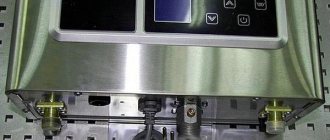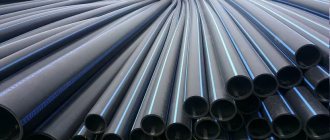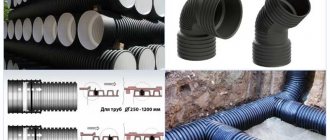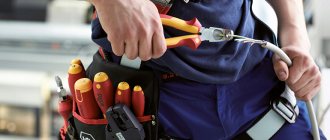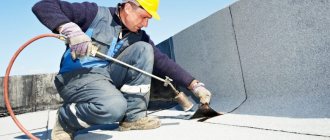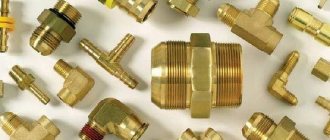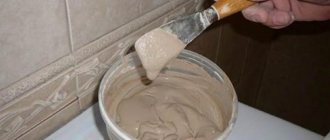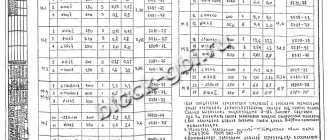Flux is a chemical substance that is used when soldering, in particular, copper pipes and helps to better fill the joint space with solder. Flux also performs another very important function - it cleans the metal product from contaminants and oxidation products. In addition, it forms a protective film that prevents the seam from coming into contact with oxygen.
Soldering copper pipes requires the use of special materials, one of which is flux
Copper pipeline soldering technology
Copper pipes are used for the installation of various communications: water pipes, heating systems and gas pipes. They have a number of advantages, such as:
- are resistant to the harmful effects of corrosion;
- the surface of copper pipes is quite smooth;
- UV resistant;
- have a high thermal conductivity coefficient;
- able to withstand high temperatures;
- have good strength;
- The service life of a copper pipeline reaches 50 years.
Note! The main disadvantage of such a pipeline is its relatively high cost, however, copper material remains popular as it is very reliable and durable.
Soldering is used to connect individual elements of a copper structure. Its varieties are as follows:
- soldering at high temperature;
- soldering at low temperature.
High-temperature soldering is used to obtain a joint with increased strength. Low-temperature soldering is used in all other cases.
Soldering components
To ensure a high-quality and strong connection of pipes, it is necessary to select the right materials for soldering.
Solder selection
Solder for soldering can be soft or hard. Hard solder has the form of rods and melts at an operating temperature of 900 degrees. With its help, high strength of pipe connections is achieved. This is an important indicator in the construction of water supply, air conditioning, refrigeration and gas supply systems.
There are two types of solders that are considered convenient and most often used:
- with the addition of Cu 94;
- with the addition of Cu 94 P 6 Ag 2.
The six percent concentration of phosphorus in the additive allows you to reduce the temperature at which copper melts to 750 degrees. The strength of the connection is achieved due to the similarity of the temperature expansion coefficients of copper and solder.
Soft solder is a wire 2-3 mm in diameter. A temperature of 300 degrees is enough to melt it, so it is usually used in household repairs. The composition of such solder includes: lead, tin and their alloys with an admixture of silver.
Flux selection
There are two types of fluxes:
- high-temperature, with an operating temperature above 450 degrees;
- low temperature, with an operating temperature below 450 degrees.
Fluxes ensure a tight connection between the solder and the metal, help prevent oxidation of the pipe, promote better cracking of the solder, and protect the soldering areas from the influence of oxygen.
Before melting the solder, the surfaces to be joined are cleaned. Then a thin layer of flux is applied evenly with a brush. After soldering the pipe parts, it is necessary to remove excess flux to prevent surface corrosion and leaks.
Selection of fittings
Fittings are parts for pipe bends, turns and thread transitions. Fitting sockets have certain diameter standards, taking into account gaps, suitable for various types of pipes. Fittings are quite expensive and, if possible, a pipe expander is used instead.
Features of soldering with flux
If we compare soldering using flux and arc soldering, in the first case the performance will be higher. The use of flux when soldering copper pipes allows the use of increased current density. The use of high currents, in turn, affects the depth of pipe melting. At the same time, you should not worry that the electrode will lose its coating material due to high temperatures.
The use of flux allows you to obtain a denser and more uniform seam
The use of flux allows you to avoid a large number of foreign inclusions, since pores do not form in the seam during soldering. Before purchasing flux for soldering copper pipelines, it is advisable to pay attention to its distinctive features. For example, to eliminate the possibility of the appearance of an oxide film, the following measures must be taken:
- Monitor the soldering temperature of soft solder for copper pipes and joints until the temperature is the same. When choosing a flux, you should pay attention to its performance. This indicator depends on the type of solder.
- If it is possible to achieve temperature uniformity between the soft joint and the solder, it can be used as a device that measures changes in temperature, which eliminates the possibility of overheating during soldering.
When purchasing a suitable solution for a particular case, you should pay attention to its quality.
Messages 13
1 Topic by Kp_glagolevo 2013-09-08 17:08:28
- Kp_glagolevo
- New member
- Inactive
- Registered: 2013-09-08
- Messages: 2
Topic: How to use nitrogen gas to solder copper pipes for air conditioners
They are installing a VRV system for me, they are soldering a lot of connections, I heard that you need to solder the tubes with nitrogen, or in nitrogen. Only the guys who do the soldering don’t use nitrogen in any form, they don’t have any nitrogen at all, at least not at the workplace. I inquired about this, they explained to me that nitrogen would be brought in later for pressure testing and cleaning the tubes from internal carbon deposits.
It seemed to me that my questions somewhat discouraged the workers; they answered somehow awkwardly. I want to figure out how nitrogen gas is actually supposed to be used for soldering copper tubes for air conditioners, during or after soldering, etc.
I would be grateful if you could briefly describe the process in a language accessible to the common man.
2 Reply from ITR 2013-09-08 22:45:41
- engineers
- Administrator
- Inactive
- From: Moscow
- Registered: 2013-03-20
- Messages: 127
Re: How to use nitrogen gas for soldering copper pipes for air conditioners
Soldering in a nitrogen environment is necessary to maintain high-quality installation; moreover, soldering VRV systems without nitrogen is completely unacceptable. Copper pipes for air conditioning, unlike water pipes, are soldered with so-called “hard” solder, which allows them to withstand the high pressure created by the compressor. Hard soldering occurs at high temperatures, the copper heats up to a red-burgundy glow, the processes occurring in copper at high temperatures destroy it.
The same scale that forms outside and inside the pipe is nothing more than burnt copper. As a result, the pipe walls become thinner. Nitrogen prevents copper from burning out from inside the pipe, and copper burnout from the outside is compensated by a thin layer of solder.
3 Reply from Ventspetsnaz 2013-09-08 22:46:48
- Ventspetsnaz
- Participant
- Inactive
- From: Leningrad
- Registered: 2013-03-30
- Messages: 201
Re: How to use nitrogen gas for soldering copper pipes for air conditioners
Soldering routes without nitrogen is, at a minimum, not professional.....
4 Reply from Kp_glagolevo 2013-09-08 23:02:33
- Kp_glagolevo
- New member
- Inactive
- Registered: 2013-09-08
- Messages: 2
Re: How to use nitrogen gas for soldering copper pipes for air conditioners
What about water pipes that are also soldered with nitrogen?
5 Reply from ITR 2013-09-08 23:29:16
- engineers
- Administrator
- Inactive
- From: Moscow
- Registered: 2013-03-20
- Messages: 127
Re: How to use nitrogen gas for soldering copper pipes for air conditioners
No, water pipes and copper pipes are not soldered with nitrogen, since they are soldered with soft solder and do not require high temperatures. Copper does not heat up to the point of glowing and therefore does not burn out.
6 Reply from lis0911 2014-06-27 21:19:16
- lis0911
- New member
- Inactive
- Registered: 2014-06-27
- Messages: 2
Re: How to use nitrogen gas for soldering copper pipes for air conditioners
I have the same problem. Can anyone tell me - when the system is soldered without nitrogen, what can be done to minimize the negative consequences? Maybe install additional filters to collect scale?
7 Reply from Ventspetsnaz 2014-06-28 20:15:28
- Ventspetsnaz
- Participant
- Inactive
- From: Leningrad
- Registered: 2013-03-30
- Messages: 201
Re: How to use nitrogen gas for soldering copper pipes for air conditioners
All equipment in the semi-industrial line is equipped with filters. But these filters are small in capacity, in terms of the fact that they are designed for small amounts of various debris (chips, scale, dust and even moisture). If we allow a VRV system consisting of 5-10 indoor units to be soldered without nitrogen, then of course the filter will become completely clogged and the system will easily go into error due to freon pressure. In this case, the filter must be cut off and a new one soldered in.
Read also: DIY feather removal machine from a washing machine
8 Reply from ITR 2014-06-28 20:21:11
- engineers
- Administrator
- Inactive
- From: Moscow
- Registered: 2013-03-20
- Messages: 127
Re: How to use nitrogen gas for soldering copper pipes for air conditioners
In this case, the filter must be cut off and a new one soldered in.
This may have to be done more than once because the scale does not fall off all at once, but gradually, about 50% at once, and the rest within a month of active use.
9 Reply from Ventspetsnaz 2014-06-28 23:55:03
- Ventspetsnaz
- Participant
- Inactive
- From: Leningrad
- Registered: 2013-03-30
- Messages: 201
Re: How to use nitrogen gas for soldering copper pipes for air conditioners
It is, of course, possible to collect scale. Now, it’s just not clear what happened to the copper pipe, how much the pipe wall burned through. If this is not a problem for conventional split systems, then for VRV it can be fatal. The VRV compressor creates pressure in the system, up to 30-40 atmospheres, and if the wall of the copper tube is greatly weakened, then depressurization of the freon circuit may occur, followed by a refrigerant leak.
10 Reply from Shatokhin Valera 2014-06-29 10:36:02
- Shatokhin Valera
- Moderator
- Inactive
- From: Dolgoprudny
- Registered: 2013-03-27
- Messages: 148
Re: How to use nitrogen gas for soldering copper pipes for air conditioners
In order for defects of poor-quality soldering of the freon circuit to appear, it is necessary to pressurize the system with a pressure exceeding the working pressure at least two to three times. Typically, for VRV systems, pressure testing is done at a pressure of 150 atmospheres.
11 Reply from Maxsim_D 2014-06-29 11:04:11
- Maxsim_D
- Participant
- Inactive
- From: Krasnodar
- Registered: 2013-03-30
- Messages: 85
Re: How to use nitrogen gas for soldering copper pipes for air conditioners
I don’t understand what installers are thinking about when they solder lines without nitrogen, what are they hoping for? Maybe to Russian?
12 Reply from ITR 2014-06-29 18:55:08
- engineers
- Administrator
- Inactive
- From: Moscow
- Registered: 2013-03-20
- Messages: 127
Re: How to use nitrogen gas for soldering copper pipes for air conditioners
Share with the forum members how it happened that they soldered the line without nitrogen?
13 Reply from Shatokhin Valera 2014-07-02 11:31:11
- Shatokhin Valera
- Moderator
- Inactive
- From: Dolgoprudny
- Registered: 2013-03-27
- Messages: 148
Re: How to use nitrogen gas for soldering copper pipes for air conditioners
Share with the forum members how it happened that they soldered the line without nitrogen?
I can answer this question. These installers don't charge much. And no, because they are altruists, but they simply put little work into their work, and then they can get it inexpensively. But why the installers do not carry out all the necessary work and technologies is a question. It’s one thing if they were sincerely mistaken and didn’t know that nitrogen, fluxes, etc. were needed. It’s another thing if installers deliberately abandoned processes that complicate installation in order to offer a lower price for their services, and at the same time not lose money.
What characteristics should a flux have for soldering copper pipes?
A high-quality flux used for soldering copper pipelines must meet certain requirements. Let's look at them:
- Regardless of the type, the composition must be evenly distributed over the working surface;
- the viscosity and density of this substance should be less than that of solder. This is necessary for substitution to occur;
- the flux must dissolve the oxide film and prevent re-oxidation of the copper part;
- in addition, such a substance should ensure a neat appearance of the seam;
- the composition should not be destroyed as a result of exposure to high temperatures;
- after soldering is completed, dirt and dust should be easily removed;
- The flux must allow soldering in both vertical and horizontal areas.
A high-quality flux in the form of a paste should be viscous and dense, then it will be evenly distributed over the surface of the pipe
A high-quality flux must have all of the above characteristics. After soldering is completed, this substance is removed using special solvents.
Preliminary preparation
Before soldering copper pipes, you need to prepare them.
Surface cleaning
The quality of the solder bundle depends on the degree of cleanliness of the surfaces being soldered. Any residues of any other substances or dirt prevent the solder from penetrating and reduce its fluidity. All this leads to the fact that the substance is not distributed evenly, the surface is not completely treated with solder. Often, because of this, it is not possible to achieve high-quality work and the connection fails.
There are two methods of metal cleaning: chemical and mechanical. The outer part of the pipe and the inside of the fitting are cleaned of oxide film, dirt and impurities using a metal brush. In addition, it is possible to use steel wool or sandpaper. After this, the solder is well distributed over the surface.
Nylon-based cleaning wipes are easy to use.
A significant advantage that distinguishes them from a metal brush or sandpaper is that after cleaning the surface with a napkin, no cleaning residue remains. After using nylon-based wipes, there are no abrasive crumbs or steel residues on the pipe.
The chemical method involves the use of an acid that reacts with oxides. You can use flux, which degreases the surface and actively fights oxides.
Using flux and assembling parts
Flux should be applied to the cleaned surface. It is applied to the section of pipe that will be connected by a fitting or socket, distribute the flux well on the surface, an excessive amount of flux can negatively affect the connection. But you should also not use flux on the inside of the fitting. Regulate the paste consumption.
After applying flux, you need to connect the parts correctly to avoid foreign particles sticking to the surface. If soldering will be done later, it will be much better if the parts are already assembled. It is necessary to turn the pipe all the way, thereby checking its connection and flux distribution. Afterwards, remove the remaining flux with a cloth prepared in advance for work. The connection can be heated.
For low-temperature soldering, fluxes are used, in the list of compositions of which aluminum chlorides are not the least important. Fluxes are hazardous substances, so care must be taken to ensure that excess does not remain on the outside of the pipe. Such carelessness can lead to metal corrosion and leakage. After soldering, inspect the surface again, there will be some flux on it due to the thermal effect. Any flux that appears on the pipe must be removed again.
For high-temperature soldering, borax is used instead of flux. It is mixed with water until it reaches a thick porridge consistency. You can use special pastes for high-temperature soldering. If you choose copper-phosphorus solder, then you do not need to purchase flux for it, it is already present in the composition. It is better to use a kit from one manufacturer, and coordinate this with the type of soldering.
Bell-shaped thickening
For connections in everyday life, either fittings for soldering copper pipes or bell-shaped thickenings are used.
It is better to choose the option with a bell-shaped thickening, so you will only need to apply one seam at the junction of the pipes.
- The ends of the parts are processed with a rolling pipe cutter. The cut must be smooth and strictly perpendicular.
- The ends of the pipes are removed from the chamfer using a chamfer remover. The inside and outside surfaces are cleaned.
- One section of pipe is clamped in a vice, and a pipe expander is inserted inside. Then you need to carefully expand the inner diameter of the pipe so that the outer diameter of the second pipe fits into it.
Before repair work, do not forget to remove plastic fragments from structures, otherwise they will melt and be unusable.
Types of fluxes
All fluxes differ from each other in various respects, but most often in the elements included in their composition. In order to clean the metal to be soldered from contaminants, the following types of fluxes are used:
- boric acid;
- zinc chloride;
- hydrochloric acid.
And to create a film that will perform protective functions, you can use:
- rosin;
- wax;
- various resins.
When soldering copper pipes, various types of fluxes can be used:
- liquid;
- powder;
- flux paste.
Liquid compositions are usually stored in closed tubes and used together with solders that have a soft consistency. Powder fluxes are less popular due to the inconvenience associated with their use during soldering. Pastes for soldering copper pipes are more expensive, however, they are sold ready-made and can be used immediately. Soldering paste allows you to simplify the process and get an incredibly strong and reliable adhesion of pipes.
Ready-made pastes are easy to use, but are more expensive than other products
Today there are a huge number of varieties of this substance. However, there are three most popular types that are used for soldering, including copper pipes:
Anti-corrosion compounds. Such substances not only perform the function of cleaning the surface from oxidation, but also remove water from the soldering area, displacing it. Using this composition allows you not to remove residues after soldering. It is quite difficult to make such a solution at home.
Compositions based on salicylic acid. In such fluxes, the main active substance is dissolved in a composition that consists of various chemicals: alcohol, petroleum jelly (technical), gold-containing substances. Such fluxes are produced only in industrial conditions and are quite popular, as they affect the quality of the seam. The seam after soldering a pipe using this flux turns out very smooth.
Helpful information! This composition can be made with your own hands at home. As a basis, you can take acetylsalicylic acid (aspirin) tablets and mix them with technical petroleum jelly and alcohol. However, such a flux will have very little heat resistance and is more suitable for soldering various electrical equipment.
Classic rosin. When assembling pipeline communications, rosin is not used in its pure form. Most often, sodium salt is mixed with it, and the result is a substance that has excellent protective and anti-corrosion characteristics for working with pipelines. Rosin envelops the seam with a protective film, and sodium salts prevent oxidative processes. This composition is cheap and is the most popular today. However, this flux also has a drawback - if it overheats, it can become charred. In addition, the seam when soldering with rosin is not as aesthetically pleasing as in the case of salicylic acid-based flux, but strong and reliable.
Rosin is the most affordable and popular material for soldering
Methods
There are two technologies for soldering copper pipes.
- Low-temperature (soft solder is used) is used in plumbing or heating systems. The environment where this technology is used must have a temperature no higher than 110 degrees.
- High-temperature soldering (hard solder) is used in systems with high temperatures and high pressure. Used primarily in industry.
Which of the two methods you choose is up to you personally. But for high-temperature soldering you need a professional torch, which is not so easy to find in a store, and it costs a lot of money. At low temperatures, it is permissible to use a blowtorch or an inexpensive hand torch with a replaceable cylinder.
Soldering pipes under nitrogen
Nitrogen treatment is necessary for installation, and soldering of copper pipes without nitrogen gas is unacceptable. Often structures are soldered with hard solder, which allows you not to worry about whether the connection will withstand high temperatures during operation. During the hard soldering process, copper is heated until the metal turns red, which has a negative effect on the structure of the material itself. Scale forms on the inner and outer surfaces of the pipe. Scale is the remains of burnt copper that formed when it was heated. The walls of the pipes become much thinner.
Nitrogen prevents the copper from thinning from the inside, and the use of solder prevents the copper from deteriorating from the outside. Soldering pipes under nitrogen will significantly increase the service life of the system.
If you decide to use nitrogen, then adhere to the following recommendations in your work:
- connect the line to a cylinder containing nitrogen;
- then install the gas regulator or rotameter;
- adjust the nitrogen cylinder reducer to the minimum nitrogen pressure, set the rotameter to a speed of 5 m/min;
- As soon as the soldering is completed, nitrogen is released through the pipe, this is done until the pipe has completely cooled down.
Read also: What is a bolt without thread called?
Soldering pipes with a construction hair dryer
It is possible to solder pipes with a heat gun if the pipe diameter is small. Manipulations with this method are similar to using a burner. With this connection, the seams are very durable and can withstand high temperatures. For beginners, copper burns are inevitable when using this method. Metal is easy to overheat, which is what causes the material to rupture.
Capillary soldering
If the pipes have different diameters (the difference is no more than 0.5 mm), use the capillary soldering method. The solder fills the resulting space between the pipes. It should be noted that there is no seam as such, a seamless connection. Then hard solders are used, their protective functions are better.
Induction soldering
High frequency current can have a beneficial effect on metal. Induction soldering has become widespread because of its uniqueness; work with this method is carried out quickly, while the material does not become thinner, but retains its qualities.
The following advantages have been identified:
- Heat is generated in the pipe without outside intervention;
- All equipment is automated, the devices help to obtain the desired result with specific parameters;
- Induction soldering is carried out in a vacuum, the metal in this environment is protected from corrosion;
- Saving production resources;
- Safety - induction soldering does not require a flame or gas, it only heats up the particular seam.
What kind of solder should I use to solder copper pipes?
There is a huge variety of solders for connecting individual elements of a copper pipeline using soldering. All of them are divided into two types according to consistency:
- hard (refractory);
- soft (low-melting).
The most popular for these purposes are low-temperature solders. They allow copper pipes to be joined at low temperatures, which eliminates the possibility of their deformation. But it is worth noting that the seams after such solder have rather low mechanical qualities.
High-temperature solders, unlike low-temperature solders, allow you to make the most durable pipe connections.
Important! It is recommended to use high-temperature solders only by experienced specialists who know all the intricacies of soldering copper products. An inexperienced person can simply burn through a copper pipe.
When low-temperature soldering, which is very popular when installing copper pipelines in domestic conditions, solders that do not contain lead are most often used. Lead-free solders provide mechanically resistant adhesion. Lead-free solders include: alloys of tin with bismuth, antimony, silver, etc. Tin in such solders contains about 95%, the remaining 5% comes from additional elements.
In domestic conditions, soft solder is most often used, which contains a large amount of tin.
For soldering at low temperatures, solder, which is an alloy of tin and lead, can be used; however, such material is not recommended for the installation of plumbing structures. This is because lead is a toxic material and can be harmful to the health of occupants.
To solder copper pipes, a special gas burner is used, which allows you to achieve maximum strength and reliability of the connection.
What is solder?
Solder is a pure metal or thermoplastic alloy made from several components. Designed to connect copper parts into a common integrated network.
When exposed to high temperatures, the solder melts, spreads across the processing area and seals the surface. After final cooling, a strong, even seam without errors is formed on the pipe material
The technology of joining two fragments, carried out according to this principle, is called soldering.
Among the main advantages of the technique it is worth highlighting:
- connection without deformation;
- preservation of the original shape of the processed parts;
- absence of any internal tension;
- excellent strength and high level of tightness of the created seam;
- resistance of the bonded area to different temperature conditions, including intense heating;
- simple separation of seam sections in case of need to change the system format.
Soldering is carried out with special equipment - a soldering iron, a gas torch or a blowtorch. Immediately before work, the area is thoroughly cleaned of surface defects and technical oils, and only then work begins.
The process of connecting pipe fragments is easy and quick, but requires mandatory compliance with basic safety rules. To avoid problems and injuries, you should wear thick work gloves on your hands, cover your face and eyes with special goggles or a mask, and protect your clothes with a thick apron. This will protect the technician from potential accidents.
For soldering at home, a soldering iron is most often used. A torch or lamp is used where the power capabilities of a soldering iron are not enough or where it is necessary to connect parts of great thickness and impressive mass.
Gas torch for connecting copper pipes
A propane torch is used to connect individual components of copper communications and allows you to work with parts at temperatures from 550 to 2000˚C. In addition, the design of the burner allows you to adjust the flame, depending on the type of solder (high or low temperature).
This device heats up quite quickly - within 10-30 seconds. A huge advantage of such a burner is its portability. It operates without being connected to the mains, which significantly expands its capabilities.
This apparatus is classified depending on the mixture on which it operates:
- mixtures of gas and air;
- mixtures of gas and oxygen.
A mixture of gas and air is used to start household burners. Their characteristics include light weight and the same dimensions. They are used for soldering small sections of pipes. And the combination of gas and oxygen allows you to work with pipes of any diameter.
Copper pipes are soldered using a gas torch, which is compact in size
Areas of application
The use of a gas burner is very extensive:
- The torch is used for soldering wiring or various cables, and repairing large electronics. Soldering aluminum with a gas torch is carried out quite often, which is due to the low melting point of this material.
- The device is used to repair various structural elements of a car. An example is the case when a radiator made of a fusible alloy is damaged. Due to exposure to high temperature, the leak can be eliminated.
- Soldering of copper tubes can be done using a gas torch. Repair work is being carried out. The device is also used during the installation of various structures, for example, for tempering metal.
- Some alloys have increased fusibility. The joining of metals, for example copper, can be done using a torch. It is enough to heat the metals and connect them mechanically. After the material has cooled, a high-quality connection can be obtained.
- The device can be used when you need to spend time outdoors in winter. It can be used to warm up a fire or singe game, warm up tools, or perform other work.
Soldering with an acetylene torch
Despite the fairly wide distribution of the torch, in most cases it is used for soldering various alloys. For example, brass soldering is carried out using a gas torch. It is worth considering that there are quite a large number of types of devices, each with its own specific features.
Safety rules for soldering copper pipes
Soldering copper pipes involves the use of soldering equipment, which requires the necessary skills. When working with soldering equipment, you should pay attention to the following safety rules:
- when sealing a pipe, it is strictly forbidden to hold a segment shorter than 30 cm in your hands under a stream of flame. This is due to the fact that copper is a very good heat conductor and you can get burned;
- If flux gets on your skin, you must immediately wash it off with water. Otherwise, you may get a chemical burn;
- When carrying out the soldering process with a torch, you need to take care of your clothes - they should only be made of natural fabrics;
- Before soldering a copper pipeline, care must be taken to ensure that the room is properly ventilated. This is necessary because the solder used to solder copper pipes emits harmful substances.
Rules for installing freon pipes of multi-zone systems:
For the installation of the cooling circuit coming from the freon installation, only copper pipes specially designed for refrigeration units are used.
During installation, you need to ensure that the pipes are located in a vertical or horizontal position. There are two exceptions to the rule:
- the suction pipeline that returns oil to the compressor must be sloped towards the compressor;
- the discharge pipeline must be sloped towards the condenser.
It is important to note that if the compressor is installed below the level of the evaporator, an oil lifting loop should be mounted at the outlet of the evaporator and the vertical part of the suction pipe should be raised above the level of the evaporator. Such measures help prevent coolant from draining and oil from entering the compressor from the evaporator. For the system to work properly, the above sequence must be repeated every seven and a half meters.
Gas welding posts
- In stock
- Wholesale / Retail
- 22.01.20
gas collapsible gas welding autonomous acetylene propane collapsible universal ROAR KRASS DM DONMET PTK KIT KGS with cylinders cart for CCGT cutter universal burner universal gas closed type cart for cylinders small cylinders
- To order
- Wholesale
- 22.01.20
The composition includes: a 5 l propane cylinder, a 2 l oxygen cylinder, reducers with pressure gauges for propane and oxygen, 5 m hoses, a burner with replaceable nozzles
- In stock
- Wholesale / Retail
- 22.01.20
Industrial assembly. Overall dimensions 600x440x180 mm. Propane
- In stock
- Wholesale / Retail
- 16.01.20
Company IP Zharkikh S.A. offers a wide range of various welding equipment and components. High quality, low prices, delivery to all regions by transport companies.
- In stock
- Wholesale / Retail
- 22.01.20
In ours you will find a wide selection of welding equipment. Delivery throughout Russia and the CIS. Please check with our managers for current prices.
- In stock
- Wholesale / Retail
- 22.01.20
VORSA Ural is a company that offers Russian organizations traditional and technically new construction equipment. We offer not just equipment, but modern high-tech solutions. The range of equipment is dynamic
Copper and aluminum connection
When connecting copper and aluminum wires by soldering, you can encounter many difficulties, which can only be overcome by using alternative connection methods.
The fact is that both aluminum and copper are covered with an oxide film in air. And if these films themselves do not affect the state of the conductor in any way and even provide fairly good conductivity, then when combined they contribute to the occurrence of a powerful chemical reaction. Under the influence of moisture contained in the air, at the point of contact between aluminum and copper oxides, the process of electrolysis begins, that is, an electric current is formed due to the fact that the ions of both materials have different electrical potentials.
Electric current is the movement of charged particles - ions, and during their movement, metals at the point of contact are destroyed. At the same time, aluminum is more destroyed. Destruction causes the contact to deteriorate, and subsequently the electrical resistance of the connection increases and it heats up. With severe corrosion, when direct contact between the two materials has already been lost, an electric arc occurs, which completes the destruction.
DIY copper soldering at home
Soft metals are quite difficult to heat treat. Soldering copper, brass and bronze at home is most often done with hard solder, although special pastes are sometimes used.
Theory
Copper is one of the oldest metals, which is used by people to create various decorations, devices and communications. It is characterized by high plasticity and pinkish-red color, sometimes with a golden tint. In the household, copper is most often used in water pipes and heating, because it does not corrode and is resistant to temperature changes.
Photo - copper connections
There are many types of soldering; capillary soldering is used for copper. It allows you to connect two parts of a pipeline or radio components as accurately and firmly as possible. This thermal effect is also divided into:
- High temperature;
- Low temperature.
High-temperature soldering is characterized by higher weld strength. In addition, it allows the connection to be thermally stable, which is very important for various communications. But at the same time, this type of work is not used on threaded connections. To carry out such soldering, special equipment is required - a burner with piezo ignition and acetyl, propane.
Photo – copper elements
Avoiding mistakes
When soldering copper tubes, novice craftsmen often make a number of common mistakes. These are:
- Poor heating of the main line elements, as a result of which the solder melts incompletely. Such a connection will collapse under any load.
- Excessive overheating of the copper alloy, on the contrary, leads to destruction of the flux layer. This, in turn, will lead to the formation of oxide and scale on the metal surface. This effect will also lead to the destruction of the connection.
- Ignoring security measures. Since work is carried out with chemical elements and at high temperatures, you should wear protective gloves and a mask.
- When planning to check the connection, you should make sure that the tube at the soldering site has cooled down.
- During the soldering procedure, it is important to ensure good ventilation of the room. This is required by the technology of the work, since soldering is performed using aggressive acidic substances.
- Protective clothing made of rough fabric will also not be superfluous, since there is a risk of flame sparks and solder particles getting on the body, which can lead to burns.
Video: technology for soldering copper tubes
Installation via thread using ferrules
Such connections are called collapsible. However, if the pipeline is replaced, the ring will still have to be replaced. Installing copper pipes in this way makes it possible to timely identify defects, leaks and timely repair connections - dismantling and replacement.
Copper pipes are connected to threads according to the following scheme:
1. Cut a piece of pipe to a certain length. 2. In case of installation of pipes insulated in PVC, it is necessary to remove the insulation at its edges. To do this, use a sharp blade to cut the insulation layer and remove its unnecessary part manually. 3. Burrs that appear after cutting a section of pipe must be removed with a file. 4. Select appropriate fittings. 5. First of all, you need to put the union nut on the pipe, then the crimp ring. 6. The nut and compression fitting must be attached. Next, you should tighten the threaded connection. The nut should first be screwed in carefully, manually if possible, and then using a special wrench. As a result, the crimp ring fits tightly around the pipe, resulting in a complete sealing of the connection between the system elements.
When connecting a fitting to transition from a steel pipe to a copper pipe, a special fum tape or traditional tow on paint must be used. I screw the fitting onto the thread, having previously wound it with tow soaked in paint or a special tape.

